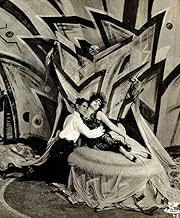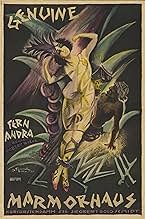Genuine
- 1920
- 1h 28m
IMDb RATING
5.9/10
1.2K
YOUR RATING
Genuine is an ancient and cruel divinity, who seduces men and induce them to kill as a proof of love.Genuine is an ancient and cruel divinity, who seduces men and induce them to kill as a proof of love.Genuine is an ancient and cruel divinity, who seduces men and induce them to kill as a proof of love.
- Director
- Writer
- All cast & crew
- Production, box office & more at IMDbPro
Featured reviews
I've just viewed the Image DVD of CALIGARI, with commentary by Mike Budd. This DVD also includes excerpts from GENUINE. While the snippets included are pretty strange and disconnected, they show a major similarity between the two films -- that is, the "frame" structure of the story. CALIGARI's frame is that it is a story told by a madman. In GENUINE, it appears that the story is a "dream" experienced by a young man who has fallen asleep reading his favorite novel. What I saw of GENUINE makes it seem the young man's favorite author was Sacher-Masoch. See also how Genuine messes up the young man's hair in a rush of passion -- shades of John Barrymore's transition scenes from DR. JEKYLL AND MR. HYDE?
I’ve been wanting to give this a whirl ever since acquiring it six years ago – as part of the Kino edition of the same director’s THE CABINET OF DR. CALIGARI (1920). However, the result (without taking into account its obvious narrative gaps, being incomplete in this version) is nowhere near as groundbreaking or even compelling as that earlier classic – despite the comparable Expressionist look (including a clock standing in for the face of a skeleton[!] and which is still its best quality).
The plot revolves around a femme fatale called Genuine – hence, the vampire of the title is not of the blood-sucking variety – who had actually been the high priestess of some cult. Due to a clash between factions, she ends up in a slave market (featuring surprising but discreet nudity) and is eventually bought by an eccentric old man (among other things, he likes to doze off while being shaved daily!), who keeps the girl in the cellar of his ‘notorious’ mansion so as to shelter her from the vices of modern life; incidentally, one is never quite sure in which era this is all supposed to be taking place – since the dapper but doddering old man has an Arab, with painted bare chest, for a servant! The irony, then, is that the girl’s own nature – she has a feral countenance and wears a skimpy striped outfit! – is infinitely more dangerous to the young men she enslaves (one of whom sports a highly anachronistic Duran Duran hairdo!). These, in fact, are somehow driven mad (as it stands, the details aren’t very clear – particularly with respect to the old man’s nephew); when the son of his exclusive barber is similarly afflicted, the latter rouses the populace against her and – in a scene which basically replicates Cesare the somnambulist’s fate from the aforementioned THE CABINET OF DR. CALIGARI – she dies in the ensuing pursuit.
In conclusion, the treatment afforded the film isn’t sufficiently gripping to rate it higher than a mere curio at this juncture; besides, it’s all the more disappointing coming from Wiene (who, besides CALIGARI also made the equally influential THE HANDS OF ORLAC [1924]). By the way, another interesting effort of his – the Dostoyevsky adaptation RASKOLNIKOV (1923) – will soon be released on DVD by the budget label Alpha (under the alternate title of CRIME AND PUNISHMENT)…
The plot revolves around a femme fatale called Genuine – hence, the vampire of the title is not of the blood-sucking variety – who had actually been the high priestess of some cult. Due to a clash between factions, she ends up in a slave market (featuring surprising but discreet nudity) and is eventually bought by an eccentric old man (among other things, he likes to doze off while being shaved daily!), who keeps the girl in the cellar of his ‘notorious’ mansion so as to shelter her from the vices of modern life; incidentally, one is never quite sure in which era this is all supposed to be taking place – since the dapper but doddering old man has an Arab, with painted bare chest, for a servant! The irony, then, is that the girl’s own nature – she has a feral countenance and wears a skimpy striped outfit! – is infinitely more dangerous to the young men she enslaves (one of whom sports a highly anachronistic Duran Duran hairdo!). These, in fact, are somehow driven mad (as it stands, the details aren’t very clear – particularly with respect to the old man’s nephew); when the son of his exclusive barber is similarly afflicted, the latter rouses the populace against her and – in a scene which basically replicates Cesare the somnambulist’s fate from the aforementioned THE CABINET OF DR. CALIGARI – she dies in the ensuing pursuit.
In conclusion, the treatment afforded the film isn’t sufficiently gripping to rate it higher than a mere curio at this juncture; besides, it’s all the more disappointing coming from Wiene (who, besides CALIGARI also made the equally influential THE HANDS OF ORLAC [1924]). By the way, another interesting effort of his – the Dostoyevsky adaptation RASKOLNIKOV (1923) – will soon be released on DVD by the budget label Alpha (under the alternate title of CRIME AND PUNISHMENT)…
The same director, cinematographer and writer of "The Cabinet of Dr. Caligari" made this subsequent picture, "Genuine". Likewise, it is also an Expressionist film (one of the few made during Weimar Germany, contrary to what Lotte Eisner and the use by some of "expressionism" as an umbrella term for almost all German cinema of the period might suggest). Additionally, similar to "Caligari", the main body of "Genuine" is framed as a dream. Yet, I wasn't engulfed into the universe of it as I was with "Caligari".
The story, although just as peculiar, isn't as involving, which is unfortunately probably, in part, because the Kino release is only a condensed version. The framing of scenes is just as prosaic and theatrical as that in "Caligari"--if not more so. As well, the stylized acting seems more overdone and obtrusive this time. But, more importantly, the problem is the sets, which I can't see the entire version improving much upon. The Expressionist set designs are equally strange, with odd angels and geometric shapes. The production, however, leaves too much space open and unfilled, which is the largest reason that "Genuine" isn't as involving, or captivating, as "Caligari".
The story, although just as peculiar, isn't as involving, which is unfortunately probably, in part, because the Kino release is only a condensed version. The framing of scenes is just as prosaic and theatrical as that in "Caligari"--if not more so. As well, the stylized acting seems more overdone and obtrusive this time. But, more importantly, the problem is the sets, which I can't see the entire version improving much upon. The Expressionist set designs are equally strange, with odd angels and geometric shapes. The production, however, leaves too much space open and unfilled, which is the largest reason that "Genuine" isn't as involving, or captivating, as "Caligari".
I caught this years back at the Paris Cinematheque hoping to find something of interest from the director of Caligari. It was a disappointment in just about every way for me. First, the film at its original length seemed to go on forever. The elements were there, granted, but they didn't combine as they did in the previous film. I had the feeling of watching a film that was going through all the necessary steps but missing all the points. It was more an exercise in style which blindly followed all the guidelines but missed going anywhere. On the other hand, and perhaps unfairly to subsequent films, "Caligari" was a one-of-a-kinder that left no space for a sequel. Period.
Curtis Stotlar
Curtis Stotlar
Robert Wiene repeats the techniques he used in "The Cabinet of Dr. Caligari" with far less success in "Genuine". His looming architectures and broad swaths of darkness are glaringly at odds with the utterly ridiculous story of the seductress-priestess-wild girl brought to unsuspecting Europe. There are some striking visual effects, such as the jungle of branches where Genuine climbs up and up to escape from her prison, but they don't add up to anything. (I should note that only fragments, adding up to about a half hour, survive of this movie; but I suspect that the parts I didn't see wouldn't have added any deeper meaning.)
Did you know
- TriviaA 43-minute condensation of this silent film can be found as an Extra Feature on the Kino Video DVD of Le Cabinet du docteur Caligari (1920). A full-length version is stored at the Munich City Film Museum archive in Germany. A VHS transfer of a full length version (with French intertitles) exists. A copy can be found on YouTube.
- Quotes
Percy Melo: Dead! She is dead!
- ConnectionsEdited into Histoire(s) du cinéma: Une histoire seule (1989)
Details
- Release date
- Country of origin
- Languages
- Also known as
- Genuine: The Tragedy of a Vampire
- Filming locations
- Production company
- See more company credits at IMDbPro
- Runtime
- 1h 28m(88 min)
- Color
- Sound mix
- Aspect ratio
- 1.33 : 1
Contribute to this page
Suggest an edit or add missing content





















